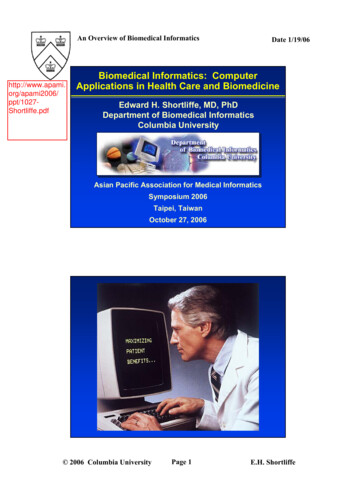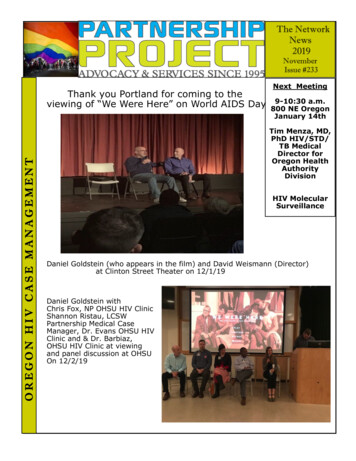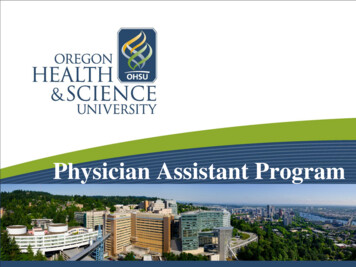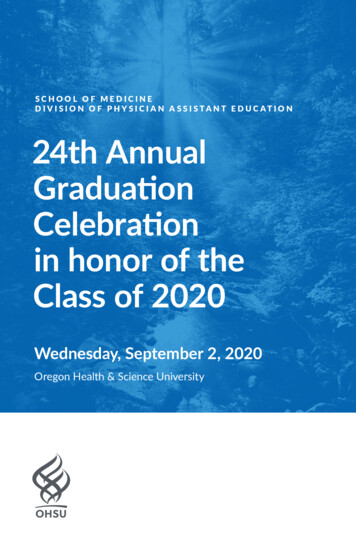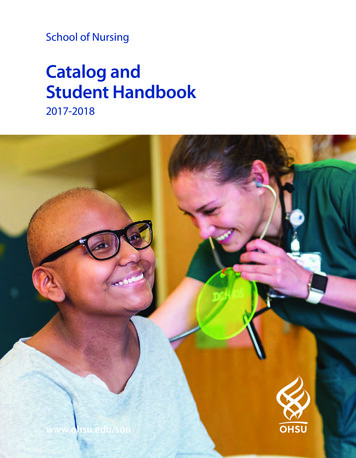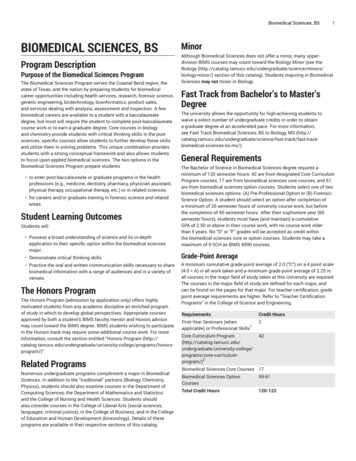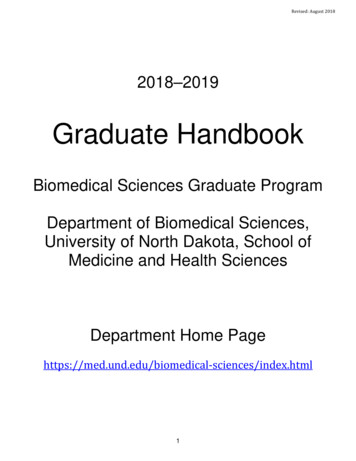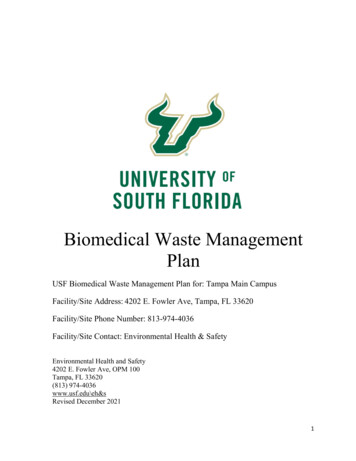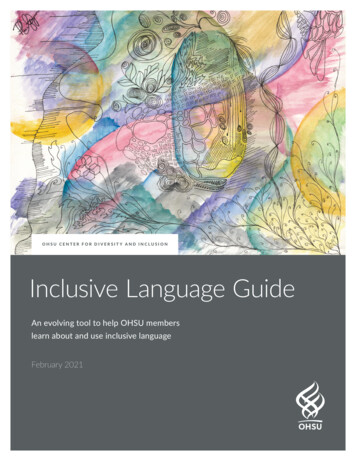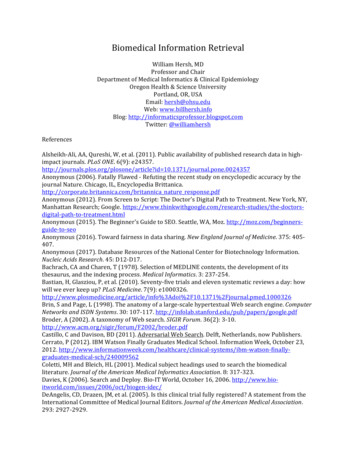
Transcription
Biomedical Information RetrievalWilliam Hersh, MDProfessor and ChairDepartment of Medical Informatics & Clinical EpidemiologyOregon Health & Science UniversityPortland, OR, USAEmail: hersh@ohsu.eduWeb: www.billhersh.infoBlog: http://informaticsprofessor.blogspot.comTwitter: @williamhershReferencesAlsheikh-Ali, AA, Qureshi, W, et al. (2011). Public availability of published research data in highimpact journals. PLoS ONE. 6(9): e24357.http://journals.plos.org/plosone/article?id 10.1371/journal.pone.0024357Anonymous (2006). Fatally Flawed - Refuting the recent study on encyclopedic accuracy by thejournal Nature. Chicago, IL, Encyclopedia ica nature response.pdfAnonymous (2012). From Screen to Script: The Doctor's Digital Path to Treatment. New York, NY,Manhattan Research; Google. he-doctorsdigital-path-to-treatment.htmlAnonymous (2015). The Beginner's Guide to SEO. Seattle, WA, Moz. http://moz.com/beginnersguide-to-seoAnonymous (2016). Toward fairness in data sharing. New England Journal of Medicine. 375: 405407.Anonymous (2017). Database Resources of the National Center for Biotechnology Information.Nucleic Acids Research. 45: D12-D17.Bachrach, CA and Charen, T (1978). Selection of MEDLINE contents, the development of itsthesaurus, and the indexing process. Medical Informatics. 3: 237-254.Bastian, H, Glasziou, P, et al. (2010). Seventy-five trials and eleven systematic reviews a day: howwill we ever keep up? PLoS Medicine. 7(9): 3Adoi%2F10.1371%2Fjournal.pmed.1000326Brin, S and Page, L (1998). The anatomy of a large-scale hypertextual Web search engine. ComputerNetworks and ISDN Systems. 30: 107-117. roder, A (2002). A taxonomy of Web search. SIGIR Forum. 36(2): dfCastillo, C and Davison, BD (2011). Adversarial Web Search. Delft, Netherlands, now Publishers.Cerrato, P (2012). IBM Watson Finally Graduates Medical School. Information Week, October 23,2012. 40009562Coletti, MH and Bleich, HL (2001). Medical subject headings used to search the biomedicalliterature. Journal of the American Medical Informatics Association. 8: 317-323.Davies, K (2006). Search and Deploy. Bio-IT World, October 16, 2006. dec/DeAngelis, CD, Drazen, JM, et al. (2005). Is this clinical trial fully registered? A statement from theInternational Committee of Medical Journal Editors. Journal of the American Medical Association.293: 2927-2929.
Ferrucci, D, Brown, E, et al. (2010). Building Watson: an overview of the DeepQA Project. AIMagazine. 31(3): 59-79. le/view/2303Ferrucci, DA (2012). Introduction to "This is Watson". IBM Journal of Research and Development.56(3/4): 1. http://ieeexplore.ieee.org/stamp/stamp.jsp?tp &arnumber 6177724Fox, S (2011). Health Topics. Washington, DC, Pew Internet & American Life althTopics.aspxFox, S (2011). The Social Life of Health Information, 2011. Washington, DC, Pew Internet &American Life Project. e-of-Health-Info.aspxFox, S and Duggan, M (2013). Health Online 2013. Washington, DC, Pew Internet & American LifeProject. ine.aspxFunk, ME and Reid, CA (1983). Indexing consistency in MEDLINE. Bulletin of the Medical LibraryAssociation. 71: 176-183.Giles, J (2005). Internet encyclopaedias go head to head. Nature. 438: n7070/full/438900a.htmlGorman, PN (1995). Information needs of physicians. Journal of the American Society forInformation Science. 46: 729-736.Hanbury, A, Müller, H, et al. (2015). Evaluation-as-a-Service: Overview and Outlook, arXiv.http://arxiv.org/pdf/1512.07454v1Haynes, RB, McKibbon, KA, et al. (1990). Online access to MEDLINE in clinical settings. Annals ofInternal Medicine. 112: 78-84.Heilman, J (2013). Online encyclopedia provides free health info for all. Bulletin of the World HealthOrganization. 91: 8-9.Hersh, W, Müller, H, et al. (2009). The ImageCLEFmed medical image retrieval task test collection.Journal of Digital Imaging. 22: 648-655.Hersh, W and Voorhees, E (2009). TREC genomics special issue overview. Information Retrieval. 12:1-15.Hersh, WR (1994). Relevance and retrieval evaluation: perspectives from medicine. Journal of theAmerican Society for Information Science. 45: 201-206.Hersh, WR (2009). Information Retrieval: A Health and Biomedical Perspective (3rd Edition). NewYork, NY, Springer.Hersh, WR, Bhupatiraju, RT, et al. (2006). Enhancing access to the bibliome: the TREC 2004Genomics Track. Journal of Biomedical Discovery and Collaboration. 1: 3. h, WR, Crabtree, MK, et al. (2002). Factors associated with success for searching MEDLINE andapplying evidence to answer clinical questions. Journal of the American Medical InformaticsAssociation. 9: 283-293.Hersh, WR, Crabtree, MK, et al. (2000). Factors associated with successful answering of clinicalquestions using an information retrieval system. Bulletin of the Medical Library Association. 88: 323331.Hersh, WR and Hickam, DH (1998). How well do physicians use electronic information retrievalsystems? A framework for investigation and review of the literature. Journal of the AmericanMedical Association. 280: 1347-1352.Hersh, WR, Hickam, DH, et al. (1994). A performance and failure analysis of SAPHIRE with aMEDLINE test collection. Journal of the American Medical Informatics Association. 1: 51-60.Hersh, WR, Müller, H, et al. (2006). Advancing biomedical image retrieval: development andanalysis of a test collection. Journal of the American Medical Informatics Association. 13: 488-496.Holan, AD (2016). 2016 Lie of the Year: Fake news. St. Petersburg, FL, h, MD (2013). Privacy threats when seeking online health information. JAMA InternalMedicine. 173: 1838-1839.
Insel, TR, Volkow, ND, et al. (2003). Neuroscience networks: data-sharing in an information age.PLoS Biology. 1: E17.Kalpathy-Cramer, J, SecodeHerrera, AG, et al. (2015). Evaluating performance of biomedical imageretrieval systems - an overview of the medical image retrieval task at ImageCLEF 2004–2013.Computerized Medical Imaging and Graphics. 39: 55-61.Laine, C, Horton, R, et al. (2007). Clinical trial registration: looking back and moving ahead. Journalof the American Medical Association. 298: 93-94.Laurent, MR and Vickers, TJ (2009). Seeking health information online: does Wikipedia matter?Journal of the American Medical Informatics Association. 16: 471-479.Lee, JS, Lorincz, C, et al. (2011). Should Healthcare Organizations Use Social Media? Falls Church, VA,Computer Sciences Corp.http://assets1.csc.com/health services/downloads/CSC Should Healthcare Organizations Use Social Media.pdfLibert, T (2015). Privacy implications of health information seeking on the Web. Communications ofthe ACM. 58(3): 68-77.Lohr, S (2012). The Future of High-Tech Health Care — and the Challenge. New york, NY. New YorkTimes. February 13, 2012. i, F, Coiera, EW, et al. (2005). General practitioners' use of online evidence duringconsultations. International Journal of Medical Informatics. 74: 1-12.Marcetich, J, Rappaport, M, et al. (2004). Indexing consistency in MEDLINE. MLA 04 Abstracts,Washington, DC. Medical Library Association. 10-11.Markoff, J (2011). Computer Wins on ‘Jeopardy!’: Trivial, It’s Not. New York, NY. New York Times.February 16, 2011. dy-watson.htmlMcHenry, R (2004). The Faith-Based Encyclopedia. Tech Central Station, November 15, lMello, MM, Francer, JK, et al. (2013). Preparing for responsible sharing of clinical trial data. NewEngland Journal of Medicine. 369: 1651-1658.Metzger, J and Rhoads, J (2012). Summary of Key Provisions in Final Rule for Stage 2 HITECHMeaningful Use. Falls Church, VA, Computer Sciences Corp.http://skynetehr.com/PDFFiles/MeaningUse Stage2.pdfNicholson, DT (2006). An evaluation of the quality of consumer health information on WikipediaCapstone, Oregon Health & Science University.Nielsen, J and Levy, J (1994). Measuring usability: preference vs. performance. Communications ofthe ACM. 37: 66-75.Perrin, A (2015). One-fifth of Americans report going online ‘almost constantly’. Washington, DC,Pew Research Center. stantly/Pluye, P and Grad, RM (2004). How information retrieval technology may impact on physicianpractice: an organizational case study in family medicine. Journal of Evaluation in Clinical Practice.10: 413-430.Pluye, P, Grad, RM, et al. (2005). Impact of clinical information-retrieval technology on physicians:a literature review of quantitative, qualitative and mixed methods studies. International Journal ofMedical Informatics. 74: 745-768.Purcell, K, Brenner, J, et al. (2012). Search Engine Use 2012. Washington, DC, Pew Internet &American Life Project. ine-Use-2012.aspxRodwin, MA and Abramson, JD (2012). Clinical trial data as a public good. Journal of the AmericanMedical Association. 308: 871-872.
Roegiest, A and Cormack, GV (2016). An architecture for privacy-preserving and replicable highrecall retrieval experiments. Proceedings of the 39th International ACM SIGIR conference on Researchand Development in Information Retrieval, Pisa, Italy. 1085-1088.Ross, JS and Krumholz, HM (2013). Ushering in a new era of open science through data sharing: thewall must come down. Journal of the American Medical Association. 309: 1355-1356.Royle, JA, Blythe, J, et al. (1995). Literature search and retrieval in the workplace. Computers inNursing. 13: 25-31.Salton, G (1991). Developments in automatic text retrieval. Science. 253: 974-980.Sánchez-Mendiola, M and Martínez-Franco, AI, Eds. (2014). Informática Biomédica, 2a Edición.Mexico City, MX, Elsevier.Shortliffe, EH and Cimino, JJ, Eds. (2014). Biomedical Informatics: Computer Applications in HealthCare and Biomedicine (Fourth Edition). London, England, Springer.Smith, M (2014). Targeted: How Technology Is Revolutionizing Advertising and the Way CompaniesReach Consumers. Washington, DC, AMACOM.Stanfill, MH, Williams, M, et al. (2010). A systematic literature review of automated clinical codingand classification systems. Journal of the American Medical Informatics Association. 17: 646-651.Strzalkowski, T and Harabagiu, S, Eds. (2006). Advances in Open-Domain Question Answering.Dordrecht, Netherlands, Springer.Taylor, H (2010). "Cyberchondriacs" on the Rise? Those who go online for healthcare informationcontinues to increase. Rochester, NY, Harris on, O, Chen, L, et al. (2004). Biological nomenclatures: a source of lexical knowledge andambiguity. Pacific Symposium on Biocomputing, Kona, Hawaii. World Scientific. 238-249.Voorhees, E and Hersh, W (2012). Overview of the TREC 2012 Medical Records Track. The TwentyFirst Text REtrieval Conference Proceedings (TREC 2012), Gaithersburg, MD. National Institute ofStandards and Technology IEW.pdfVoorhees, EM (2005). Question Answering in TREC. TREC - Experiment and Evaluation inInformation Retrieval. E. Voorhees and D. Harman. Cambridge, MA, MIT Press: 233-257.Voorhees, EM and Harman, DK, Eds. (2005). TREC: Experiment and Evaluation in InformationRetrieval. Cambridge, MA, MIT Press.Voorhees, EM and Tong, RM (2011). Overview of the TREC 2011 Medical Records Track. TheTwentieth Text REtrieval Conference Proceedings (TREC 2011), Gaithersburg, MD. National Instituteof Standards and TechnologyWanke, LA and Hewison, NS (1988). Comparative usefulness of MEDLINE searches performed by adrug information pharmacist and by medical librarians. American Journal of Hospital Pharmacy. 45:2507-2510.Westbrook, JI, Gosling, AS, et al. (2005). The impact of an online evidence system on confidence indecision making in a controlled setting. Medical Decision Making. 25: 178-185.Wu, S, Liu, S, et al. (2017). Intra-institutional EHR collections for patient-level information retrieval.Journal of the American Society for Information Science & Technology: in press.Yandell, MD and Majoros, WH (2002). Genomics and natural language processing. Nature Reviews Genetics. 3: 601-610.Zarin, DA and Tse, T (2013). Trust but verify: trial registration and determining fidelity to theprotocol. Annals of Internal Medicine. 159: 65-67.Zarin, DA, Tse, T, et al. (2015). The proposed rule for U.S. clinical trial registration and resultssubmission. New England Journal of Medicine. 372: 174-180.Zarin, DA, Tse, T, et al. (2011). The ClinicalTrials.gov results database--update and key issues. NewEngland Journal of Medicine. 364: 852-860.
Biomedical Information RetrievalWilliam Hersh, MDProfessor and ChairDepartment of Medical Informatics & Clinical EpidemiologyOregon Health & Science UniversityPortland, OR, USAEmail: hersh@ohsu.eduWeb: www.billhersh.infoBlog: http://informaticsprofessor.blogspot.comTwitter: @williamhersh1Topics to cover Content Indexing Evaluation21
Content Current status and challenges in biomedicalinformation retrieval (IR) Classification and examples of knowledgebased information3Challenges in biomedical IR We have gone from information paucity toinformation overload Many topics we want to search on have multipleways to be expressed– e.g., diseases, genes, symptoms, etc. The converse is a problem too: Many words andterms used to express topics have multiplemeanings Balancing open access vs. providing for cost ofproduction and maintenance42
IR is now “mainstream” Internet (and likely search engine)use is now ubiquitous– Not only in developed countries (Perrin,2015) but across world –http://www.internetworldstats.com/stats.htm 71% of Internet users (59% of USadults) have searched for healthinformation, with 35% using it forself-diagnosis (Fox, 2013)“Search engine optimization” (SEO)is a key function used by manycompanies and organizations (Moz,2015)– https://moz.com/beginners-guide-toseo– Some are lucky, e.g., last name of“Hersh”5The Web has changed the nature ofsearch Three major uses (Broder, 2002)– Informational – seeking information (39-48%)– Navigational – looking for a specific page, e.g., a home page (2024%)– Transactional – perform transactions, e.g., on-line purchasing(30-36%) We are in the era of “adversarial” search – there is contentwe do not want to retrieve (Castillo, 2011; Smith, 2014)– Some of the content we might not want to retrieve is “fakenews,” which came to the fore in 2016 (Holan, 2016) Growing privacy concerns about tracking our searching(Huesch, 2013; Libert, 2015)63
IR also a growing part of “knowledgediscovery” from scientific literatureAll literaturePossibly relevantliteratureDefinitely trievalInformationextraction,text mining7IR and online access firmly planted inhealth and biomedicine Biology is now defined as an “information science”(Insel, 2003) Pharmaceutical companies compete forinformatics/library talent (Davies, 2006) Clinicians cannot keep up – average of 75 clinical trialsand 11 systematic reviews published each day (Bastian,2010) Search for health information by clinicians, researchers,and patients/consumers is ubiquitous (Purcell, 2012;Google/Manhattan Research, 2012)– It’s even part of “meaningful use” – text search overelectronic health record notes (Metzger, 2012)84
Use is ubiquitous among physicians(Google/Manhattan Research, 2012) Most have multiple devices – 99% with a desktop or laptop, 84% with asmartphone, and 54% with a tabletSpend twice as much time using online resources as print resourcesEven physicians aged 55 heavy users – 80% own a smartphone, 84% use searchengines daily, and 9 hours per week is spent online for professional purposesSearch engine use a daily activity – 84%, with average of six searches done per dayand 94% using GoogleWhen looking for clinical or treatment information, about a third click first onsponsored listings from a searchAbout 93% say they take action based on searching – everything from pursuingmore information to sharing with a patient or colleague to changing treatmentdecisionsOn smartphones, searching is preferred over mobile apps – 48% of use time with asearch engine, 34% with mobile apps, and 18% going to specific Web sites in abrowser or with a bookmarkSpend about 6 hours per week watching online video, with about half of that timespent for professional purposes9What kind of health information doconsumers search for? (Fox, 2011)Health topic% searchingSpecific disease or medical problem66%Certain medical treatment or procedure56%Doctors or other health professionals44%Hospitals or other medical facilities36%Health insurance – private or government33%Food safety or recalls29%Environmental health hazards22%Pregnancy and childbirth19%Medical test results16%105
How to find more informationabout IR in health and biomedicine Hersh WR, InformationRetrieval: A Health andBiomedical Perspective, ThirdEdition, 2009– Web site: www.irbook.info Chapters in other books, e.g.,Shortliffe (2014), SanchezMendiola (2014) Plenty of other books, journals,and other sources11Why is IR pertinent to healthand biomedicine? Growth of knowledge has long surpassed human memorycapabilities Clinicians have frequent and unmet information needs Researchers must frequently update their knowledge in newareas quickly Primary literature on a given topic can be scattered and hardto synthesize Non-primary literature sources are often neithercomprehensive nor systematic Web is increasingly used as source of health and biomedicalinformation126
Life-cycle of c datarepositoryWrite upresultsRejectPeerreviewAcceptSubmit forpublication13Classification of knowledge-basedscientific information Primary – original research– Published mainly in journals but also in conferenceproceedings, technical reports, books, etc.– Can include re-analysis, e.g., meta-analysis andsystematic reviews Secondary – reviews, condensations, and/orsynopses of primary literature– Textbooks and handbooks are staples of clinicalpractitioners, researchers, and others– Guidelines are important for normalizing care andmeasuring quality147
Classification of knowledge-basedcontent Bibliographic– By definition rich in metadata Full-text– Everything on-line Annotated– Non-text or structured text annotated with text Aggregations– Bringing together all of the above These categories are admittedly fuzzy, and increasingnumbers of resources have more than one type15Bibliographic content Bibliographic databases– The old (e.g., MEDLINE) have been revitalized with newfeatures– New ones (e.g., National Guidelines Clearinghouse) haveemerged Web catalogs– Share many characteristics of traditional bibliographicdatabases Real simple syndication/Rich site summary (RSS)– “Feeds” provide information about new content168
Bibliographic databases Contain metadata about (mostly) journal articlesand other resources typically found in libraries Produced by– U.S. government – most produced by National Libraryof Medicine (NLM, www.nlm.nih.gov) e.g., MEDLINE, genomics information, etc.– Commercial publishers, e.g., EMBASE – part of larger SciVal CINAHL – Cumulative Index to Nursing and Allied HealthLiterature ACM Guide to Computing Literature – computer science andrelated areas17MEDLINE References to biomedical journal literature– Original medical IR application – system for searchingMEDLINE launched in 1971 with literature maintained inMEDLARS system dating back to 1966 Name derives from MEDLARS On-Line – MEDLINE– Free to world since 1997 via PubMed – http://pubmed.gov Now with links to full text of articles and other resources sd key.htmlOver 23M references to peer-reviewed literatureOver 5600 journals, mostly English languageNearly 900,000 new references added yearly189
National Guidelines Clearinghouse Produced by Agency for Healthcare Research andQuality (AHRQ)– www.guideline.gov Contains detailed information about guidelines– Including degree they are evidence-based– Interface allows comparison of elements in databasefor multiple guidelines Has links to those that are free on Web and linksto producers when proprietary19Web catalogs Generally aim to provide quality-filtered Websites aimed at specific audiences– Distinction between catalogs and sites blurry Some are aimed towards clinicians– HON Select – http://www.hon.ch/HONselect/– Translating Research into Practice –www.tripdatabase.com Others are aimed towards patients/consumers– Healthfinder – www.healthfinder.gov2010
RSS RSS “feeds” provide short summaries, typically of news,journal articles, or other recent postings on Web sites Users receive RSS feeds by an RSS aggregator that cantypically be configured for the site(s) desired and to filterbased on content– Work as standalone, in Web browsers, in email clients, etc. Two versions (1.0, 2.0) but basically provide– Title – name of item– Link – URL of full page– Description – brief description of page21Full-text content Contains complete text as well as tables,figures, images, etc. If there is corresponding print version, bothare usually identical Includes– Periodicals– Books– Web sites – may include either of above2211
Full-text primary literature Almost all biomedical journals available electronically– Many published by Highwire Press (www.highwire.org),which adds value to content of original publisher, includingBritish Medical Journal, Journal of the American MedicalAssociation, New England Journal of Medicine, etc.– Also published by leading commercial scientific publishers,e.g., Elsevier, Kluwer, Springer, etc.– Growing number available via open-access model, e.g.,Biomed Central (BMC), Public Library of Science (PLoS)– Another source of full-text papers is PubMed Central(PMC; http://pubmedcentral.gov)23Books Textbooks– Most well-known clinical textbooks are now availableelectronically e.g., Harrison’s Principles of Internal Medicine– Most are bundled into large collections by publishers e.g., Access Medicine (McGraw-Hill), Elsevier, Kluwer– NLM has developed books site as part of Entrez http://www.ncbi.nlm.nih.gov/books Compendia of drugs, diseases, evidence, etc. Handbooks – very popular with clinicians Increasingly published on mobile devices2412
Value added for electronic books Multimedia, e.g., skinlesions, shuffling gait ofParkinson’s Disease, etc. Bundling of multiplebooks Can be updated inbetween “editions” Linkage to otherinformation, e.g., toreferences, selfassessments, updates,other resources, etc.25Web sites Defined more narrowly here to refer tocoherent collections of information on Web Usually take advantage of Web features, suchas linking, multimedia Increasingly integrated with other resourcesand available on different platforms (e.g.,integrated into electronic health records[EHRs], on smartphones, etc.)2613
Some notable full-text content on Websites Government agencies– National Cancer Institute www.cancer.gov– Centers for Disease Control – travel and infectioninformation http://www.cdc.gov/DiseasesConditions http://www.cdc.gov/travel/– Other NIH institutes, e.g., National Heart, Lung,and Blood Institute (NHLBI) www.nhlbi.nih.gov27Full-text Web sites (cont.) Physician-oriented medical news and overviews, e.g.,– Medscape – www.medscape.com– Many professional societies provide to members, e.g.,http://www.acponline.org/clinical information/ Patient/consumer-oriented, e.g.,– NetWellness – www.netwellness.com– WebMD – www.webmd.com Many mobile apps provide health information, e.g.,– iTriage – www.itriagehealth.com– Epocrates – www.epocrates.com2814
Other interesting types of Webcontent Wikipedia – www.wikipedia.org– Encyclopedia with free access and distributed authorship– Some concerns about manipulation (McHenry, 2004) but Comparable to Encyclopedia Britannica? (Giles, 2005 – rebuttal:Anonymous, 2006) Health information quality is reasonably good (Nicholson, 2006) Content retrieved prominently in most Web searches (Laurent, 2009) Making attempt to improve quality of medical content (Heilman,2013) Body of knowledge– Software Engineering Body of Knowledge (SWEBOK,www.swebok.org) organizes knowledge of field Social media/Web 2.0 and beyond (Lee, 2011)29Annotated Non-text or structured text annotated withtext Includes– Image collections– Citation databases– Evidence-based medicine databases– Clinical decision support– Genomics databases– Other databases3015
Image collections Most prominent in the “visual” medical specialties, such asradiology, pathology, and dermatology Well-known collections include– Visible Human –http://www.nlm.nih.gov/research/visible/visible human.html– Lieberman’s eRadiology – http://eradiology.bidmc.harvard.edu– WebPath – � More pathology – PEIR, www.peir.net– DermIS – www.dermis.net– More dermatology, also a decision-support system –www.visualdx.com Many have associated text, which assists with indexing andretrieval31Citation databases Science Citation Index and Social Science CitationIndex– Database of journal articles that have been cited byother journal articles– Now part of a package called Web of Science, whichitself is part of a larger product, Web of Knowledge(Clarivate) ch/research-discovery/web-of-science/ SCOPUS – http://www.elsevier.com/onlinetools/scopus Google Scholar – http://scholar.google.com3216
Evidence-based medicine databases Cochrane Database of Systematic Reviews –http://www.cochrane.org– Collection of systematic reviews, kept updated Evidence “formularies”– Clinical Evidence (BMJ) –http://clinicalevidence.bmj.com/x/index.html– JAMAevidence – http://jamaevidence.com PubMed Health –https://www.ncbi.nlm.nih.gov/pubmedhealth/– Systematic reviews and summaries of systematic reviews Many resources part of aggregations33Clinical decision support (CDS) Content used in CDS systems, usually part of EHRs– Order sets (usually “evidence-based”)– CDS rules– Health/disease management templates Growing and evolving commercial market forsuch tools, especially as EHR adoption increases;leaders include– Zynx – www.zynxhealth.com– Thomson Reuters Cortellis –http://cortellis.thomsonreuters.com– EHR vendors themselves and partners3417
Genomics databases National Center for Biotechnology Information (NCBI,www.ncbi.nlm.nih.gov; NCBI, 2017) collection links– Literature references – MEDLINE– Textbook of genetic diseases – On-Line MendelianInheritance in Man– Sequence databases – Genbank– Structure databases – Molecular Modeling Database– Genomes – Catalog of genes– Maps – Locations of genes on chromosomes35Other databases ClinicalTrials.gov– www.clinicaltrials.gov– Originally database of clinical trials funded by NIH– Now used as register for clinical trials, with resultsreporting for some (DeAngelis, 2005; Laine, 2007;Zarin, 2013; Zarin, 2015) NIH RePORTER– http://projectreporter.nih.gov/reporter.cfm– Database of all research grants funded by NIH– Replaced the CRISP database3618
Data publishing Internet makes it technologically feasibleMany fields have long tradition of requiring depositing of data in publicrepository as a condition to publish, e.g., genomics, although availabilityincomplete (Alsheikh-Ali, 2011)Growing advocacy for clinical trials data– A “public good” (Rodwin, 2012) for new era of “open science” (Ross, 2013)– Calls for doing so by journal editors (Taichman, 2016) and others (Ross, 2013;Mello, 2013)– Pushback from trialists who want time-limited protection of those whogenerate data for rewards of their work and from those who aim to discreditor undermine original research (Anonymous, 2016) biomedical and healthCAre Data Discovery Index Ecosystem (bioCADDIE)– Database of metadata about available biomedical data sets– https://datamed.org/37Aggregations – integrating manyresources Clinical – growing tendency of publishers toaggregate resources into comprehensive products– Merck Medicus – www.merckmedicus.com Collection of many resources available to any licensed USphysician– Up to Date – www.uptodate.com Very popular among clinicians– Essential Evidence Plus (includes InfoPOEMS, “Patientoriented evidence that matters”) –www.essentialevidenceplus.com– Dynamed – www.dynamed.com3819
Other aggregations Biomedical research: Model organismdatabases, e.g., Mouse Genome Informatics– www.informatics.jax.org– Combines genomics and related data,bibliographic database, gene references, etc. Consumer: MEDLINEplus– http://medlineplus.gov– Integrates a variety of licensed resources andpublic Web sites39Indexing Assignment of metadata to content tofacilitate retrieval Two major types– Human indexing with controlled vocabulary– Automated indexing of all words Also address– Indexing other “objects”– UMLS Metathesaurus– Web indexing4020
Human indexing Usually performed by professional indexerwith some
Biomedical Information Retrieval William Hersh, MD Professor and Chair Department of Medical Informatics & Clinical Epidemiology Oregon Health & Science University
